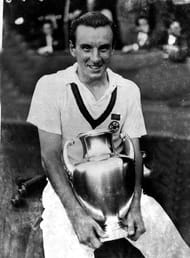A New Home
With the event becoming increasingly popular and attracting far more crowds than the 200 people who had witnessed the first final, the Club decided to move to a new home. A new Centre Court was commissioned and Wimbledon could now host 13,500 enthusiastic spectators.
But even that didn’t prove to be enough and another show court was required. Court No. 1, which opened in 1924, could originally accommodate 3,250 people.
Centre Court, which today is an iconic sporting venue, has witnessed some of the greatest tennis matches of all time. Keeping pace with the times, press boxes, large screens, scoreboards and hawk-eye cameras have found a home in the venue as well. Between 2007 and 2009, Centre Court received one of its most major operations. With a retractable roof added over the court along with artificial lighting, rain delays and fading light have ceased to plague the event with stoppages.
Today, the court has a capacity to hold 15,000 spectators.
The Last Briton No More
Wimbledon history is incomplete without Fred Perry. Already a table tennis champion when he switched to tennis, Perry, with his impressive fitness and training regime (he trained with Arsenal FC), delighted the British as he won a hat-trick of Wimbledon titles culminating in 1936.
He was the first male Briton to win the tournament in over two decades then. And till two weeks ago, he was the last Briton to win for nearly eight!
The first televised Championships
Wimbledon has the unique honour of being the first sport to be televised live. In 1937, for 30 minutes each day, those within a 40 mile radius of the event could watch live tennis from the comfort of their home. The telegraph reported that, “You could observe every movement of the players and even the passage of the marks of the lawnmower over the grass were distinctly visible.”
Today, the Championships have an estimated global audience of around 378 million in 198 countries with combined footage of over 15,388 hours.
The Wars
The Championships were not held between 1915 and 1918 and again between 1940 and 1945 due to the wars. During the Second World War, the Club remained only minimally functional and was used to station several troops. Its proximity to London and its fame meant that it would be under constant threat from aerial bombers. This threat became a reality when the court was attacked in October 1940, when several 500lb bombs fell around the borough of Wimbledon and some fell on the Centre Court roof and stands. A portion of the roof was destroyed along with 1,200 seats. The damage was there to be seen when the tournament was resumed in 1946.
The advent of the Open Era
Some of the greatest players of the 50s and 60s never returned to the Majors after a few appearances because of the sport’s unwillingness to accept professionals. Names like Rosewall, Gonzalez, Laver, Emerson and Hoad were lost because of the reluctance of those who ran the prestigious events to pay for those who played in them. Private promoters paid much better for ‘Pro-Tours’ and once these players went professional, there was no returning to the ‘amateur only’ slams.
However, in 1968, the tide had changed and the French Open became the first Major to allow professionals and amateurs to compete together. A month later, Wimbledon followed suit and offered the winner a prize of £2,000.
Starting 2007, women were given the same prize money as men. In 2012, the winner took home £1.6 million. And the entire purse for the tournament is £22 million.

